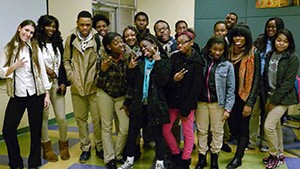 DURING VISITS TO her hometown of Baltimore while she was a student at Pomona, Celia Neustadt ’12 started to notice some interesting shifts in the makeup of the city’s public spaces. The Inner Harbor waterfront, long seen by locals as a tourist-only enclave, had started attracting black teens from around the city looking for a place to shop and meet friends, a big change from when Neustadt herself was a Baltimore City high school student.
DURING VISITS TO her hometown of Baltimore while she was a student at Pomona, Celia Neustadt ’12 started to notice some interesting shifts in the makeup of the city’s public spaces. The Inner Harbor waterfront, long seen by locals as a tourist-only enclave, had started attracting black teens from around the city looking for a place to shop and meet friends, a big change from when Neustadt herself was a Baltimore City high school student.
The influx of a new crowd, however, had also sparked new tensions. Complaints and concerns from business owners over loitering, theft and “rowdy” behavior were leading to curfews that prevented groups of teens from enjoying thedowntown district at night and after school, and bans that kept them out of popular clothing stores. Negative iteractions with police and security staff added to the resentment felt by Baltimore youth. The friction was palpable, Neustadt recalls, as she walked around the Harbor one night after an Orioles baseball game.
“Not only were there more teenagers than I remembered, but it felt kind of tense. There was a feeling in the air, like if someone lit a match, it would spread like wildfire.”
Intrigued and concerned, Neustadt came back to Pomona for her senior year and began making connections between her own observations and concepts she was studying as a sociology major.
“I had become really interested in these ideas about the power of public spaces,” she says. “I wanted to see if teens were intentionally staking a claim to this space, and figure out how they were using it.”
Neustadt channeled her curiosity into a proposal for a youth-led research team that would help amplify the voices of young people of color who felt excluded from the area. After winning a Napier Grant designed to promote leadership in social change, she went back to Baltimore the summer after her graduation and kicked off a new community organization, the Inner Harbor Project (IHP).
Since its launch in 2012, the IHP has brought together a cohort of high school students from neighborhoods around Baltimore to try to uncover the sources of conflict in the city’s downtown. Building on a tradition in social justice work known as participatory action research, the IHP’s student staffers have combed the city to hold focus groups with other teens, while also interviewing stakeholders such as land developers, security companies and business owners.
The conversations have shed some much-needed light on the issue. Community leaders now have a better understanding of why the Harbor is so valuable to young people looking for a vibrant and inclusive space to call their own.
“Teenagers don’t have that many places to go to in Baltimore, and so they really flock to the Inner Harbor,” Neustadt explains. “They feel like they’ve lucked into this larger world.”
Still, the project has also put a focus on problems like encounters between teens and police, which often cause mistrust and lead to more serious confrontations down the road. To create a takeaway for policymakers and officials, the group used its findings to draw up a list of proposals to reduce tensions and improve safety, catching the attention of local media and politicians. Some of their recommendations were even incorporated into the city’s most recent master plan for the waterfront district.
Neustadt, who says the response from City Hall and local businesses has been “overwhelmingly positive,” credits the Inner Harbor Project’s success to the teens themselves and their ability to draw upon their own lived experiences.
“This organization is about recognizing the extreme potential that these young people have to effect change in their city,” she insists. “They and only they have the answers to this issue that has people at the city level scratching their heads.”
While Neustadt is modest about her own contributions, others stress how her clear values and vision laid the foundation for the program and the positive results that have followed.
“I think Celia’s commitment to community and change has been instrumental in this work,” says Professor of Sociology and Chicana/o-Latina/o Studies Gilda Ochoa, a trusted mentor from Pomona who encouraged Neustadt to involve youth in the project and work from their perspective.
Looking ahead, Neustadt is hopeful that the organization might serve as a model for other cities that struggle with conflict between police and youth of color at their tourist attractions, mentioning locations like the French Quarter in New Orleans and Millennium Park in Chicago.
“This is my attempt to create a little ounce of change, to create a structure for having a discussion about inequality and the way spaces are used. I don’t see myself doing anything else for a long time.”
